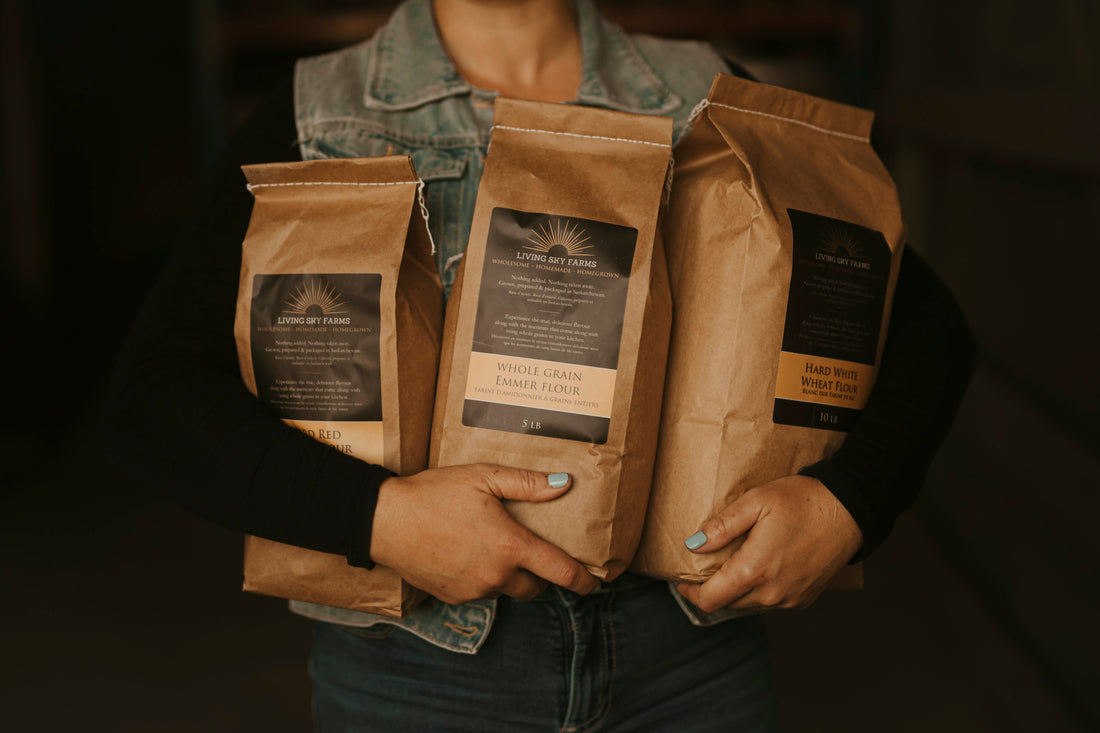
Flour 101: Which grain should I use?
Choosing the right type of grain flour for your baking project can make all the difference in the outcome! While there are some grains that can be used universally across various recipes, learning which one is best suited for which types of baking, can not only improve your chances for success but take your baking to the next level!
We created a handy printable that tells you which grains are best suited for certain recipes, so you can print it and stick it on the inside of a kitchen cabinet, or pantry door for quick reference when you're baking. Make sure to download it after you've read this so it all makes sense.

First and foremost, there are quite a few different grains, and it can be a little overwhelming when you first get started. But generally, they all fall into a few simple categories which makes it much easier to remember.
1. Hard grain 2. Soft grain 3. Legumes and 4. Seeds
Hard Grains are things like Hard Wheats (red and white), Durum, Emmer, Khorasan/Kamut, Spelt, Triticale, Millet, Rice, Amaranth, Buckwheat and Corn.
Generally speaking, these grains have a higher protein (10-14%) and a lower moisture content, making the grains physically harder and more resistant to milling. To put one of these grains in your mouth and try to chew it, it will noticeably 'crack' in your mouth *don't try this with corn though, it may crack your teeth rather than the corn.*
These grains are easily ground into an exceptionally fine flour using a stone mill, thanks to their lower moisture content allowing the flour to flow smoothly between the stones. The higher protein content also typically means a stronger gluten structure, which corresponds with the strength (rise/elasticity) in your dough. Because of this, hard grains are the top choice grains for baking yeasted breads or making pasta.
A quick note though; while Millet, Rice, Amaranth, Buckwheat and Corn are all high-protein hard grains, they do not contain the proteins that form gluten. Make sure to find recipes specifically for these grains before simply swapping them out with your favorite recipes to ensure success.
Also, if you're going to mill corn in your stone mill can I offer a suggestion? Open up your stones to a very, very coarse grind and run the corn through once just to crack it, making the kernels the size of a wheat seed first. Then after you've done that, tighten up your stones to the fine grind you're after, and run the cracked corn through a second time. This will not only help to speed up the process of getting a fine flour from such a large corn kernel, but it will also protect your milling stones as the corn is truly just such a hard grain.
BEST USES; Sandwich breads, artisanal breads, sourdough, buns, baguettes, pastas, tortillas, etc.
Soft Grains are things like Soft Wheats (red and white), Einkorn, Barley, Oats, Rye, and Quinoa.
Soft grains typically have higher moisture and lower protein. The lower protein corresponds with a softer crumb and lighter texture, so are great for cakes, cookies, muffins, etc. If you put one of these grains in your mouth and chew it? You'll simply chew it; it won't shatter in your mouth or hurt your teeth. These grains also will not hold much gluten structure on their own so are recommended more for quick breads; recipes that use baking soda or baking powder as their rising agent, or have another ingredient that holds the dough together ie) vital wheat gluten or xanthan gum.
The higher moisture content does require a little extra attention with your stone mill though. If you grind soft grains too fine, they can mush into your stones as the flour doesn't flow out quite as easily as the drier, hard grains. It's nothing to worry about, the flour will simply stop flowing out of your mill spout if you've got it too fine, and simply running rice through your machine will clear it out no problem! But because the grain itself is so much softer, it's also much easier to get just as fine of a flour, with a coarser setting on your stone mill! So try opening up your stones a few notches and feel the flour between your fingers, you'll see what I mean and learn exactly what works best for you and your mill!
Another note? Oats are borderline considered an oilseed because they have a very high oil content. Different oat varieties are better than others for milling (perhaps a topic for another day), but you may need to open up your stones quite a bit to get oat flour to flow freely through your stones.
BEST USES; cakes, pastries, pancakes, waffles, muffins, cookies, scones, pie crusts, etc.
You can also go ahead and use the hard grains in quick breads as well, just be mindful not to overmix them. The gluten-forming proteins in hard grains can sometimes result in a dense, rubbery end result rather than the light airy result you're after in quickbreads.
Legumes would be your Beans, Peas, Lentils, and Chickpeas. Peanuts technically fit in this category too being that they ARE a legume, but for the sake of this conversation please consider them nuts. They will create a butter rather than a flour, and are 100% NOT recommended for milling. You will destroy your stones and void any warranty on your flour mill - stay away from nuts in a stone mill.
Other than peanuts though, legumes are a great addition to your flour repertoire. They add incredible fibre, nutrition and flavor, and are a great alternative for gluten-free baking. They make great thickening agents for stews or sauces, and binding agents for patties or fritters.
To mill legumes in your stone mill, I would recommend following the same process as my note on milling corn and running it through once to get a cracked meal, then second to get a fine flour. Simply for the sake of size; chickpeas and kidney beans are quite large, and they may not even flow into your stone chamber if the stones are set for too fine a grind right off the hop.
BEST USES; additions to sauces, gluten-free savory baking, binding patties together, etc.

Seeds include things like Flax, Hemp, Chia, and Sesame seeds. All are great additions to your baking and provide great flavor, texture and nutrition, but because of the oil content, should not be put through a stone mill at any point.
If you'd like to crack the seeds, I'd recommend a food processor, a coffee grinder, or the steel rollers of KoMo's Flakers also do a wonderful job. You can also try soaking them overnight in a buttermilk or beer soaker before adding to a dough recipe - the flavor combinations are endless!
BEST USES; additions to any baking.
At the end of the day, your kitchen is like a cozy science lab - so play around! Try different things and find what you like. My favorite advice is to pick one recipe and stick with it, tweaking things here or there until you love it. Each kitchen is going to be different in terms of humidity and air temp, how the sun shines in and heats your house during the day, or even the tools you use for mixing or what brand of baking powder you use, so you really do need to find what works best for you. But simplifying the types of grains and knowing when to use each one can boost your confidence to keep experimenting and trying new things.
If you'd like to keep a copy of this handy in your kitchen, you can download and print our helpful reference sheet here! Take a picture once you've got it up and tag us on social media! We'd love to know if this is helpful for you.




2 comments
When using a hard flour in a bread machine do the recipes need to be adapted with extra moisture?
Hi there,
Which type of flour would be best for sourdough ?